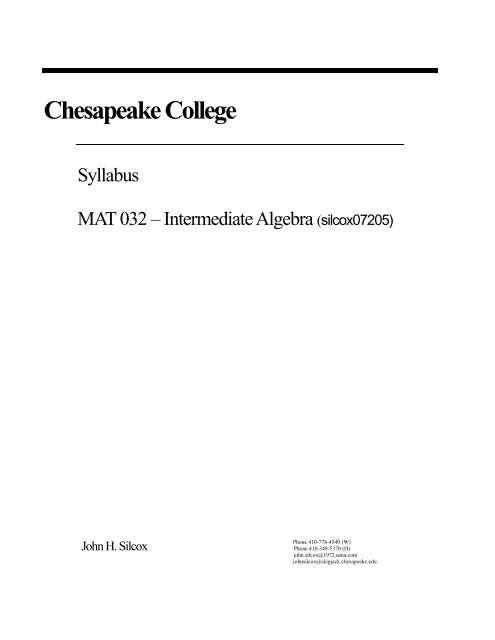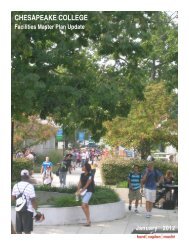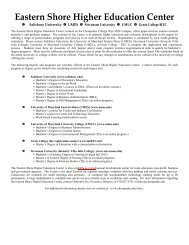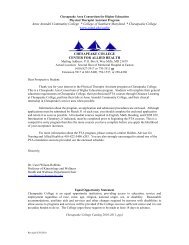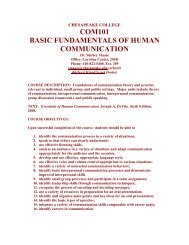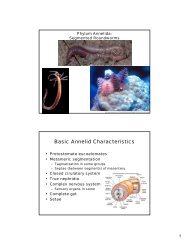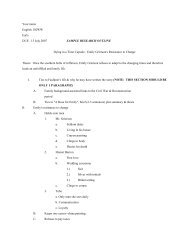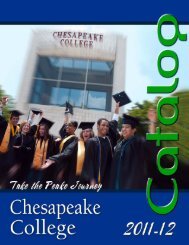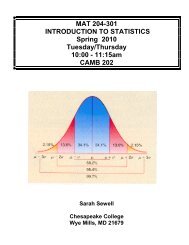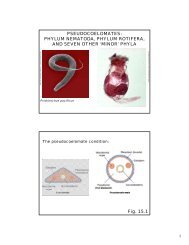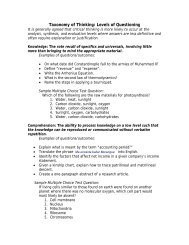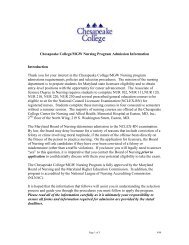Syllabus For MAT 032 - Chesapeake College
Syllabus For MAT 032 - Chesapeake College
Syllabus For MAT 032 - Chesapeake College
You also want an ePaper? Increase the reach of your titles
YUMPU automatically turns print PDFs into web optimized ePapers that Google loves.
<strong>Chesapeake</strong> <strong>College</strong><br />
<strong>Syllabus</strong><br />
<strong>MAT</strong> <strong>032</strong> – Intermediate Algebra (silcox07205)<br />
John H. Silcox<br />
Phone 410-778-4540 (W)<br />
Phone 410-348-5370 (H)<br />
john.silcox@1972.usna.com<br />
johnsilcox@skipjack.chesapeake.edu
<strong>Syllabus</strong> <strong>For</strong> <strong>MAT</strong> <strong>032</strong><br />
I. OFFICE HOURS: One hour before each scheduled class start time.<br />
II.<br />
COURSE DESCRIPTION:<br />
The course is designed as a continuation of beginning algebra. Topics included are systems of<br />
equations and graphs, polynomials in several variables, fractional expressions and equations,<br />
radical expressions and equations, quadratic equations and inequalities.<br />
Three hours per week, three load hours, and 0 credits.<br />
PREREQUISITE: <strong>MAT</strong> 031 or appropriate score on the placement test.<br />
III.<br />
TEXTBOOK:<br />
Foundations of Mathematics by Marvin L. Bittinger and Judith A. Penna. Addison Wesley. 2004<br />
ISBN # 0-321-16856-9<br />
IV.<br />
INTRODUCTION:<br />
Intermediate Algebra is approximately equivalent to the second year of high-school algebra, and<br />
is the final course in developmental algebra offered at <strong>Chesapeake</strong> <strong>College</strong> in preparation for<br />
college level mathematics courses. It serves as the final prerequisite for the entry level General<br />
Education credit mathematics courses. The topics covered are included in the Course<br />
Description. Graphing calculators may also be used to further illustrate specific concepts and<br />
while not required, would enhance your learning.<br />
In addition to the lectures, the average student should plan to spend six hours outside of<br />
class each week (2 hours for every hour spent in class).<br />
Students whose background in mathematics is not strong or those who normally work at a<br />
slower than average pace, should schedule more time in order to keep up with the course<br />
material.<br />
NOTE: <strong>College</strong> policy prohibits young children from accompanying parents to class.<br />
V. GRADES:<br />
This course consists of all or parts of chapters #10, #11, #12, #15, #16 and #17 in the assigned<br />
textbook. The following syllabus outlines in detail the material that will be presented from each<br />
of the chapters, and the intended order of presentation. The numerical final course grade will be<br />
computed as indicated in the following distribution, and letter grades will be assigned as<br />
follows:<br />
2
Components of Final Grade<br />
Letter Grade<br />
In-Class Activities 5% A : 90% - 100%<br />
Homework 5% B : 80% - 89 %<br />
Quiz/Test Average 65% C : 70% - 79%<br />
Final Examination 25% F : less than 70%<br />
VI.<br />
ATTENDANCE:<br />
Students whose attendance is sporadic do not do well because of the nature of the course,<br />
especially in the accelerated format. In addition, since in-class activities constitute 5% of the<br />
student's final grade, (one-half of a letter grade); it is to the benefit of each student to be<br />
present at every class session. Most students need guidance in understanding procedures<br />
involved in developing a new mathematical process. If you find yourself unable to keep up<br />
with the class, make an appointment immediately to see the instructor outside of class time.<br />
It is the student's responsibility to make up any work missed due to an absence for any<br />
reason.<br />
VII.<br />
TESTING:<br />
Dates for tests are indicated on the last page of this syllabus. Students should make every<br />
effort to be present for class on those days, but should it be absolutely necessary to miss a<br />
scheduled test, the student should contact the instructor as early as possible to make other<br />
arrangements for testing. A separate make-up test will be given only for an extreme<br />
emergency, and will be scheduled at the instructor's convenience.<br />
If you are absent prior to a scheduled test, you will still be expected to take the test at the<br />
scheduled time and are expected to contact a fellow student or the instructor in advance to<br />
obtain the information required to prepare for the test.<br />
3
COURSE OUTLINE<br />
CHAPTER TOPIC COVERED PAGES<br />
1 – 9 Moving to Intermediate Algebra 3 – 779<br />
(Discussion of basic prerequisite material)<br />
Ten Factoring Polynomials 749 – 827<br />
Eleven Rational Expressions & Equations 833 – 915<br />
Fifteen Radical Expressions & Functions 1119 – 1191<br />
16.1 – 16.6 Quadratic Expressions & Functions 1197 – 1257<br />
12.1 – 12.3+ .5 Graphs, Functions & Applications 929 – 978<br />
17.1 – 17.3 Exponential and Logarithmic Functions 1289 – 1336<br />
Final Examination: Review Sheet Included<br />
Although you will be tested on the subject matter of each chapter, tests for specific sections may be<br />
combined so as to maximize course effectiveness. The above outline may be modified slightly as<br />
necessary to accommodate student needs. A brief description of the Objectives for each chapter and the<br />
Homework Assignments are detailed on the following pages.<br />
Homework Assignments will be due on the day scheduled for the chapter test and will include<br />
those sections covered in the previous class lectures. Late homework will be accepted only for halfcredit<br />
and may be returned ungraded. It is expected that each student will be able to solve ALL of the<br />
exercise problems in each section covered, even though only about 33% of the exercise problems are<br />
specifically assigned. The answers to the odd numbered problems are given in the back of the textbook.<br />
NOTE: In order to receive full credit for your homework, the assigned problems<br />
must be written out and all work must be shown.<br />
4
Moving to the Intermediate Algebra Level:<br />
CHAPTER OBJECTIVES<br />
In order to comfortably succeed in <strong>MAT</strong> <strong>032</strong> you will need to be proficient in the following skills. If<br />
you need to brush up on any of these skills please ask for help immediately!<br />
Basic equation solving<br />
Solving application problems<br />
Adding, subtracting, multiplying, dividing polynomials<br />
Evaluating exponential expressions<br />
Factoring Trinomials, factoring by grouping<br />
After completing each chapter the student should be able to accomplish the following:<br />
OBJECTIVES:<br />
Chapter Ten – Polynomials: Factoring<br />
1. Factor monomials, binomials & trinomials using the GCF.<br />
2. Factor sums and differences of cubes.<br />
3. Solve quadratic equations by factoring.<br />
4. Apply quadratic equations and solve.<br />
NOTE: In order to receive full credit for your homework, the assigned problems<br />
must be written out and all work must be shown.<br />
Homework: (Read 10.1 - 10.9; pp. 749 – 824)<br />
Work the following assigned exercises at the end of each section.<br />
Sec. 10.1 pp. 749 - 784 9 – 27 by 3's, 32 - 44 by 4's<br />
Sec. 10.2 pp. 755 - 764 5 – 60 by 5's<br />
Sec. 10.3 pp. 765 - 773 5 – 75 by 5's<br />
Sec. 10.4 pp. 774 - 779 5 – 85 by 5's<br />
Sec. 10.5 pp. 780 – 789 10 – 80 by 5’s, 99 – 126 by 9’s<br />
Sec. 10.6 pp. 790 – 794 4 – 32 by 4’s, 49, 53, 56<br />
Sec. 10.7 pp. 795 – 803 7 – 77 by 7’s, 92 – 104 by 4’s<br />
Sec. 10.8 pp. 804 – 812 4 – 56 by 4’s, 58, 60, 83, 84<br />
Sec. 10.9 pp. 813 – 824 5 – 35 by 5’s, 49, 52, 56<br />
5
Chapter Eleven – Rational Expressions & Equations<br />
OBJECTIVES:<br />
1. Know that rational expressions are ratios or quotients of polynomials.<br />
2. Add, subtract, multiply and divide rational expressions.<br />
3. Solve rational equations.<br />
4. Solve applications involving work and motion.<br />
5. Solve applications involving ration and proportion.<br />
NOTE: In order to receive full credit for your homework, the assigned problems<br />
must be written out and all work must be shown<br />
Homework: (Read 11.1 – 11.9; pp. 833 – 912)<br />
Work the following assigned exercises at the end of each section.<br />
Sec. 11.1 pp. 833 – 843 4 – 72 by 4’s and 88 – 92 even<br />
Sec. 11.2 pp. 844 – 848 4 – 36 by 4’s 42 – 48 even<br />
Sec. 11.3 pp. 849 – 852 1 – 47 odd<br />
Sec. 11.4 pp. 853 – 860 4 – 60 by 4’s, 78, 80<br />
Sec. 11.5 pp. 861 – 868 4 – 52 by 4’s, 65, 68<br />
Sec. 11.6 pp. 869 – 874 4 – 32 by 4’s, 43 – 45<br />
Sec. 11.7 pp. 875 – 884 4 – 44 by 4’s, 57 – 63 odd<br />
Sec. 11.8 pp. 885 – 899 4 – 48 by 4’s, 69, 72<br />
Sec. 11.9 pp. 900 – 912 2 – 6 even, 8 – 48 by 8’s<br />
Chapter Fifteen – Radical Expressions & Functions<br />
OBJECTIVES:<br />
1. Evaluate square roots and the graph of y x .<br />
2. Examine cube roots, fourth roots, n th roots.<br />
3. Use rational exponents to evaluate and simplify expressions.<br />
4. Add, subtract, multiply and divide radical expressions.<br />
5. Solve radical equations.<br />
6. Examine the 1 .<br />
NOTE: In order to receive full credit for your homework, the assigned problems<br />
must be written out and all work must be shown.<br />
6
Homework: (Read 15.1 – 15.8; pp. 1119 – 1187)<br />
Work the following assigned exercises at the end of each section.<br />
Sec.15.1 pp. 1119 – 1130 1 – 27 odd, 42 – 78 by 6’s, 91<br />
Sec.15.2 pp. 1131 – 1137 4 – 84 by 4’s<br />
Sec.15.3 pp. 1138 – 1146 4 – 88 by 4’s, 97 – 99<br />
Sec.15.4 pp. 1147 – 1152 5 – 70 by 5’s, 83 – 84<br />
Sec.15.5 pp. 1153 – 1158 4 – 32 by 4’s, 41<br />
Sec.15.6 pp. 1159 – 1170 5 – 55 by 5’s, 72 – 81 by 3’s<br />
Sec.15.7 pp. 1171 – 1176 1 – 11 odd, 15 – 30 by 5’s<br />
Sec.15.8 pp. 1177 – 1187 5 – 95 by 5’s<br />
OBJECTIVES:<br />
Chapter Sixteen – Quadratic Equations & Functions<br />
1. Solve quadratic equations by completing the square.<br />
2. Solve quadratic equations using the Quadratic <strong>For</strong>mula.<br />
3. Solve applications involving quadratic equations.<br />
4. Graph quadratic equations<br />
5. Solve polynomial and rational inequalities.<br />
NOTE: In order to receive full credit for your homework, the assigned problems<br />
must be written out and all work must be shown.<br />
Homework: (Read 16.1 – 16.8; pp. 1197 – 1280)<br />
Work the following assigned exercises at the end of each section.<br />
Sec. 16.1 pp. 1197 – 1209 4 – 52 by 4’s<br />
Sec. 16.2 pp. 1210 – 1217 4 – 44 by 4’s, 48, 50, 51<br />
Sec. 16.3 pp. 1218 – 1228 5 – 45 by 5’s<br />
Sec. 16.4 pp. 1229 – 1237 4 – 28 by 4’s, 30 – 50 by 5’s<br />
Sec. 16.5 pp. 1238 – 1248 2 – 18 even<br />
Sec. 16.6 pp. 1249 – 1257 3 – 18 by 3’s, 35 (Solve using y ax<br />
h k<br />
2<br />
7
Chapter Twelve – Graphs, Functions & Applications<br />
OBJECTIVES:<br />
1. Use the vertical line test to determine if a graph is a function.<br />
2. Find the domain and the range of a function.<br />
3. Given an equation, derive the slope-intercept form and determine the slope and y-<br />
intercept.<br />
4. Graph two equations, to determine whether they are parallel or perpendicular.<br />
5. Given sufficient information, write the equation of a line.<br />
NOTE: In order to receive full credit for your homework, the assigned problems<br />
must be written out and all work must be shown.<br />
Homework: (Read 12.1 – 12.3 + 12.5)<br />
Work the following assigned exercises at the end of each section.<br />
Sec. 12.1 pp. 929 – 935 3, 7, 16, 22, 31, 36, 41, 47, 48, 55, 61, 73<br />
Sec. 12.2 pp. 939 – 940 4, 8, 13, 27, 30, 37, 38, 51<br />
Sec. 12.3 pp. 950 – 951 4, 11, 16, 20, 23, 29, 30, 43, 47<br />
Sec. 12.5 pp. 975 – 978 3, 6, 20, 26, 31, 36, 41, 45, 52<br />
OBJECTIVES:<br />
Chapter Seventeen – Polynomials: Factoring<br />
1. Examine exponential functions and their graphs.<br />
2. Determine inverses of functions.<br />
3. Find the composition of functions.<br />
4. Examine logarithmic functions and their graphs.<br />
NOTE: In order to receive full credit for your homework, the assigned problems<br />
must be written out and all work must be shown.<br />
Homework: (Read 17.1 – 17.3; pp. 1289 – 1336)<br />
Work the following assigned exercises at the end of each section.<br />
Sec. 17.1 pp. 1289 – 1303 1, 3, 10, 16, 29<br />
Sec. 17.2 pp. 1304 – 1321 3 – 27 by 3’s, 35 – 49 odd, 63<br />
Sec. 17.3 pp. 1322 – 1332 1, 5, 8 – 32 by 4’s, 36 – 66 by 6’s, 72, 77<br />
8
REVIEW FOR FINAL EXAMINATION<br />
The Final Examination for this course consists of approximately fifty computational problems. The<br />
problems are similar to those that you have worked to complete each chapter. One way to review all of the<br />
material from this course is to work the Summary and Review Exercises located at the end of each chapter.<br />
These highlights review the major definitions and concepts of the chapter, and an example of each concept<br />
is presented. If you have any difficulties you should review that section of the chapter more thoroughly. If<br />
you have any questions please get them answered before the scheduled final exam date.<br />
The following is a partial list of the tasks that may be included on the Final Examination.<br />
1. Reduce algebraic fractions.<br />
2. Add, subtract, multiple, and divide rational expressions.<br />
3. Solve fractional equations.<br />
4. Solve systems of linear equations by various methods.<br />
5. Solve applications problems that involve systems of linear equations.<br />
6. Simplify radicals.<br />
7. Add, subtract, multiply, and divide radicals.<br />
8. Simplify expressions containing fractional exponents.<br />
9. Solve radical equations.<br />
10. Solve quadratic equations by various methods.<br />
11. Solve application problems that contain quadratic equations.<br />
12. Find the inverse of a function.<br />
13. Solve an elementary exponential equation.<br />
14. Solve an elementary logarithmic equation.<br />
15. Apply the properties of logarithms.<br />
16. Solve an application involving logarithms.<br />
G O O D L UC K ! ! - S T UD Y H A R D ! !<br />
9


